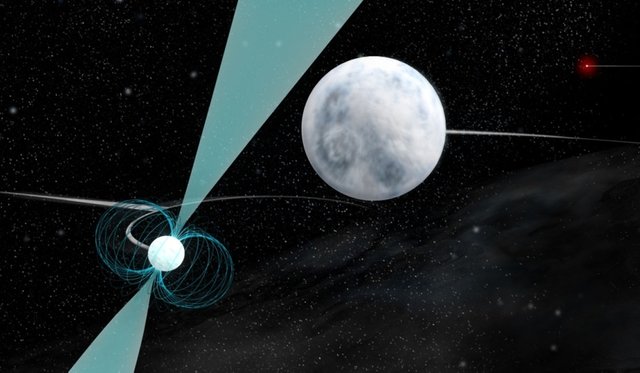The first white pulsar was discovered in the Universe after half a century of research!
The researchers were able to observe for the first time a white neutron star. While the star is the size of Earth, it contains 200,000 times more mass and an electromagnetic field that is 100 million times stronger. So far, hundreds of pulsars were discovered, all of whom were trained in the same way: the core of a massive star explodes and turns into a neutron star. But the new pulsar discovered is completely different.

The first pulsar was detected accidentally in 1960 when astronomers were looking for extragalactic radio sources. At that time the team was expected that the pulsar is a type of white dwarf planet, but when analyzed a pulsar in the Crab nebula's center, they realized that no white star could not swirl or vibrate so strongly.
Neutron stars are different from white dwarf stars, by dialing mode. Although both are remnants of former stars, white dwarfs, however, are the result of low mass stars with gradually collapsing while neutron stars are formed in catastrophic explosions of massive stars.
Because of the difference in mass, neutron stars have much higher temperatures, during the formation turning faster and stronger magnetic fields than white dwarf stars. Researchers have predicted the existence of neutron stars since 30 years ago. Since then, they have theorized that the pulsars could influence the binary system, a system consisting of two astronomical bodies at short distances from each other that the gravitational pull to make it both to orbit around the same center of mass.
The team from Warwick University, UK and the South African Astronomical Observatory have identified the star Scorpii AR (AR Sco) as the first version of a pulsar, which is 380 light years from Earth.
Tom Marsh from the University of Warwick said:
The new data demonstrate that AR Sco brightness is highly polarized, so magnetic field emissions controls the entire system.
The experts claim that they have not seen such an object in the Universe until now.
A triple system that gives us a natural cosmic laboratory
Researchers have found a pulsar with two white dwarfs, all three stars are crammed into a space smaller than Earth's orbit around the sun.

Unusually close orbits of the three stars allow scientists to make precise measurements of gravity, which could help solve some difficulties in Einstein's theories.
Scott Ransom from National Radio Astronomy Observatory (NRAO) in the US explained:
This triple system gives us a natural cosmic laboratory far better than anything found before for learning exactly how such three-body systems work and potentially for detecting problems with general relativity that physicists expect to see under extreme conditions.
Pulsars emit lighthouse-like beams of radio waves that rapidly sweep through space as the stars spin on their axes. These stars are formed after a supernova collapses a star consumed in a dense ball of neutrons strongly magnetized.
Subsequent observations revealed that the pulsar is in a close orbit of a white dwarf star, and that pair of stars is in orbit with another white dwarf, a little more distant.
This animation shows the unique triple-star system with a superdense neutron star and two white dwarf stars. The neutron star is a pulsar, emitting lighthouse-like beams of radiation as it spins on its axis. These beams, in blue, are seen sweeping through space as the neutron star rotates. At the start, you see this pulsar and its close companion white dwarf in orbit around their common center of mass. The animation zooms outward, showing this pair also in orbit with a more-distant, cooler white dwarf, and illustrates the motions of these three bodies. The entire system would fit within Earth's orbit around the Sun.
This is a fascinating system in many ways, including what must have been a completely crazy formation history, and we have much work to do to fully understand it.
This post has been ranked within the top 80 most undervalued posts in the second half of Feb 14. We estimate that this post is undervalued by $5.15 as compared to a scenario in which every voter had an equal say.
See the full rankings and details in The Daily Tribune: Feb 14 - Part II. You can also read about some of our methodology, data analysis and technical details in our initial post.
If you are the author and would prefer not to receive these comments, simply reply "Stop" to this comment.
Ole!